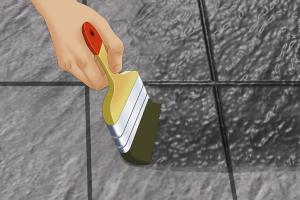Ultimate Guide to Polishing Slate: Techniques, Tools, and Tips

-
Quick Links:
- Introduction
- Understanding Slate
- Benefits of Polishing Slate
- Preparation for Polishing Slate
- Step-by-Step Guide to Polish Slate
- Case Studies
- Expert Insights
- Maintenance Tips for Slate
- FAQs
Introduction
Slate is a metamorphic rock known for its durability and versatility, often used in flooring, countertops, and roofing. However, over time, slate surfaces can lose their luster due to wear, stains, or environmental factors. This comprehensive guide will teach you how to polish slate effectively, restoring its natural beauty and extending its lifespan. Whether you're a DIY enthusiast or a homeowner looking to maintain your slate surfaces, this guide will provide you with the knowledge and tools you need.
Understanding Slate
Slate is composed of fine-grained metamorphic rock that can be split into thin layers. It is available in various colors, including grey, green, blue, and even red. Understanding the composition and characteristics of slate is crucial for effective polishing. Here are some key points:
- Composition: Slate is primarily made up of clay minerals and quartz, which contribute to its strength and versatility.
- Types of Slate: There are various types of slate, including roofing slate, flooring slate, and decorative slate, each with unique properties.
- Natural Finish vs. Polished Finish: Slate can be left in its natural state or polished for a glossy finish, which enhances its color and depth.
Benefits of Polishing Slate
Polishing slate surfaces offers several benefits:
- Enhances the natural colors and patterns of the slate.
- Increases the durability and resistance to stains.
- Provides a smooth surface that is easier to clean and maintain.
- Restores the slate's aesthetic appeal, making it look new again.
Preparation for Polishing Slate
Before you begin polishing, it's essential to prepare your slate surfaces properly:
- Gather Your Tools: You will need a soft-bristle brush, a vacuum cleaner, a mild detergent, a microfiber cloth, and a polishing compound.
- Clean the Surface: Remove any dirt, dust, or debris using a soft-bristle brush and vacuum cleaner.
- Inspect for Damage: Check for any cracks or chips in the slate that may need repair before polishing.
Step-by-Step Guide to Polish Slate
Now that you are prepared, follow this step-by-step guide to polish your slate surfaces:
Step 1: Cleaning the Slate
Start by thoroughly cleaning your slate surface. Use a mixture of mild detergent and water, applying it with a soft cloth. Avoid harsh chemicals as they can damage the slate.
Step 2: Applying the Polishing Compound
Once the slate is clean and dry, apply a stone polishing compound. Use a clean, dry cloth to spread the compound evenly over the surface.
Step 3: Buffing the Slate
Using a polishing pad or a soft cloth, buff the slate in circular motions. This action will help the polishing compound penetrate the surface and enhance the shine.
Step 4: Wiping Off Residue
After buffing, use a clean microfiber cloth to wipe off any excess polishing compound. Ensure that no residue is left on the slate.
Step 5: Final Inspection
Inspect the slate surface for any dull spots or areas that may need additional polishing. Repeat the buffing process if necessary.
Case Studies
To further illustrate the effectiveness of polishing slate, here are two case studies:
Case Study 1: Residential Slate Flooring
A homeowner with a slate floor noticed that it had become dull over the years. After following the polishing guide, the floor regained its original shine and was much easier to clean, reducing the time spent on maintenance.
Case Study 2: Slate Countertops in a Restaurant
A restaurant owner sought to maintain the aesthetic appeal of slate countertops. Regular polishing not only improved the look but also increased the surface's resistance to stains from food and beverages.
Expert Insights
We consulted with stone care experts to gather insights on slate maintenance:
"Regular maintenance and polishing can significantly extend the life of slate surfaces. It's important to use the right products and techniques to avoid damaging the stone." - Jane Doe, Stone Care Expert
Maintenance Tips for Slate
To keep your slate surfaces looking their best, consider these maintenance tips:
- Clean up spills immediately to prevent stains.
- Use coasters and mats to protect the surface from scratches.
- Re-polish slate every 6 to 12 months, depending on usage.
- Avoid harsh chemicals and abrasive cleaning tools.
FAQs
1. How often should I polish my slate?
It is recommended to polish slate surfaces every 6 to 12 months based on usage.
2. Can I use vinegar to clean slate?
No, vinegar can damage the slate. Use a mild detergent mixed with water instead.
3. What should I do if my slate is scratched?
For minor scratches, polishing can help. For deeper scratches, consider consulting a professional.
4. Is polishing slate difficult?
No, polishing slate is a straightforward process that can be done by anyone with the right tools and techniques.
5. Can I use a regular floor cleaner on slate?
It is best to use a cleaner specifically designed for stone surfaces to avoid damage.
6. What type of polishing compound should I use?
Use a high-quality stone polishing compound specifically formulated for slate or natural stone.
7. How do I maintain the polish on my slate?
Regular cleaning and re-polishing as needed will help maintain the shine on your slate.
8. Can I use a buffer to polish slate?
Yes, a buffer can make the polishing process easier and more effective, especially on larger surfaces.
9. Will polishing make my slate slippery?
Polishing can make slate slightly more slippery; consider using a non-slip treatment if this is a concern.
10. Is professional polishing necessary?
For most homeowners, DIY polishing is sufficient. However, a professional can be consulted for extensive damage or large areas.
Random Reads